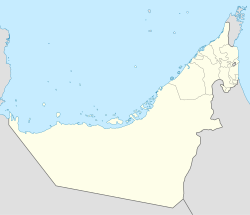Wadi Saham is a seasonal watercourse in the Hajar Mountains of Fujairah, in the United Arab Emirates. It is notable for its petroglyphs, including a single rock bearing 26 petroglyphs across four faces.
Contents
Wadi Saham | |
|---|---|
| Coordinates: 25°06′46″N56°12′32″E / 25.112808°N 56.208962°E | |
| Country | United Arab Emirates |
| Emirate | Fujairah |



